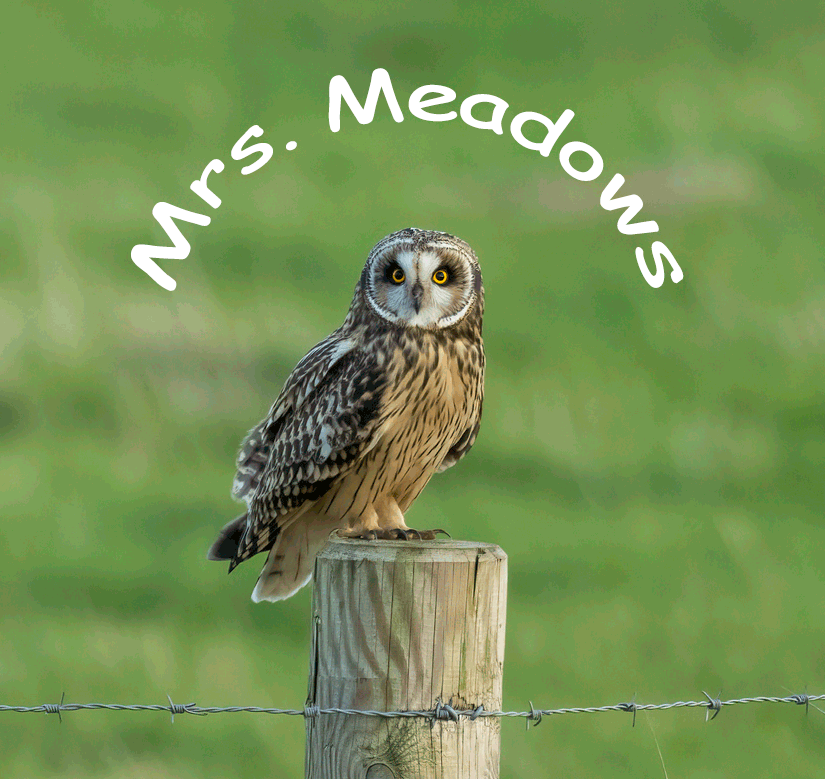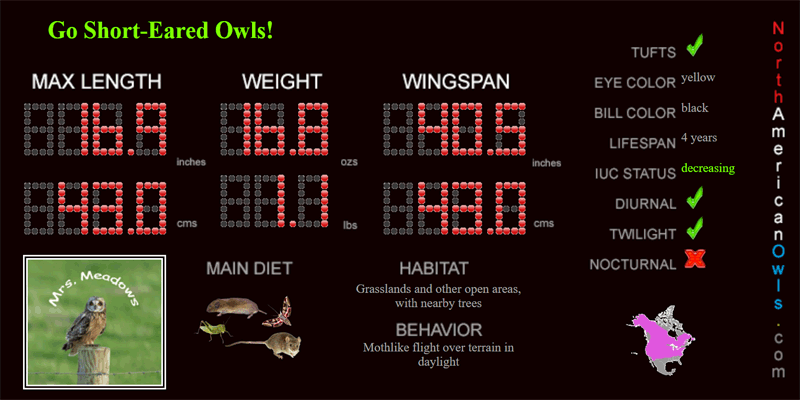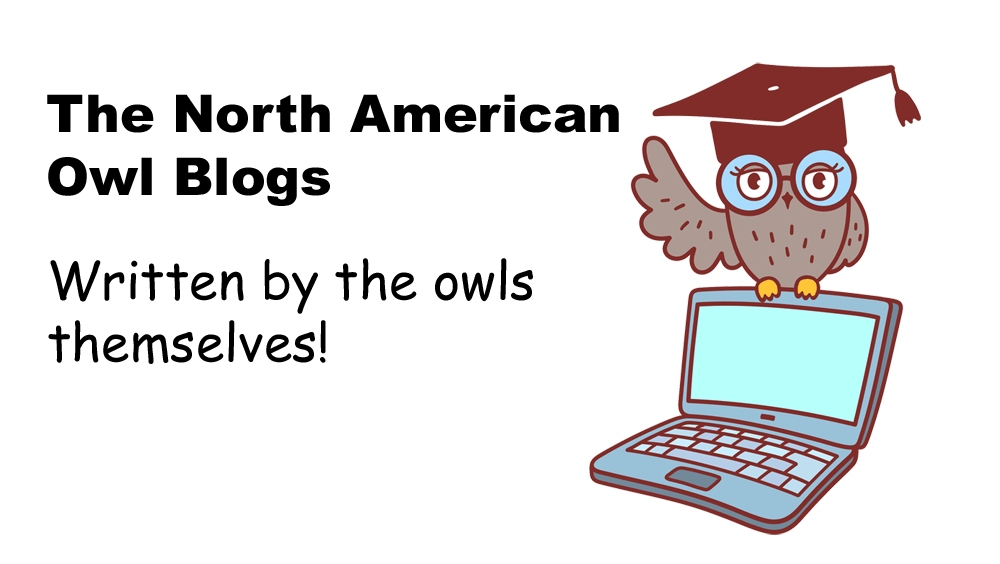
photo credit: Rachel Bennett
May I have this sky dance?
January 20, 2025
Oh, I had a wonderful time at the North American Owl Awards this year. In fact, I could have danced all night... Sky-danced, that is!
I trust you watched the ceremony on TV last night, live from Tufts University? Did you see my species win the award for Best Courtship Display in a North American Owl? Yep. We won for our Short-eared Owl Sky Dance!
They're always saying how my species flies like a moth or a bat as we patrol grasslands and marshes for voles and other rodents1, but this award proves that we Short-Eared Owls are no one-trick ponies when it comes to flight. We can be quite acrobatic when we feel like it -- or rather when the male of our species feels like it.
The guys take to the air to impress us females and if they succeed, then it's game on. We become "an item," as they say. We don't necessarily pair for life, like Great Horned Owls2, but we'll commit for at least one entire breeding season. I almost said, we tough it out for at least one entire breeding season. Ha ha! Before you know it, I'm brooding over anywhere from 4 to 12 little white eggs, depending on the size of the vole population in any given year.3 It takes the little darlings about a month to hatch. Meanwhile, the male defends yours truly and brings in food for the wee ones4. Fast-forward another four weeks and the cuties strike out on their own, what your ornithologists call fledging, I believe.5 What a to-do!
And to think, it all started with an innocent little Sky Dance!
Speaking of which, there's another male showing off right now, about 200 feet over my head. I wish I had a poster board and a marker pen so that I could write down a rating to show him when he lands. I don't know why we have to do so much communication by body language alone. Still, to be honest, I'm a pushover as a judge. I almost always hand out 10's... unless the male forgets to bring me a decent-sized rodent when he's done. Then I'll be like, "What's up with that? Am I not worth so much as one single vole???"
Listen to the North American Owl Awards ceremony, live from Zimman Field at Tufts University in Medford, Massachusetts!
1: Short-eared Owl, New York Department of Environmental Conservation
2: Great Horned Owl Life History, Cornell Lab: All About Birds
3: Short-eared Owl Life History, Cornell Lab: All About Birds
4: Short-eared Owl, Audubon
5: Short-Eared Owl, Animalia
January 20, 2025
Oh, I had a wonderful time at the North American Owl Awards this year. In fact, I could have danced all night... Sky-danced, that is!
I trust you watched the ceremony on TV last night, live from Tufts University? Did you see my species win the award for Best Courtship Display in a North American Owl? Yep. We won for our Short-eared Owl Sky Dance!
They're always saying how my species flies like a moth or a bat as we patrol grasslands and marshes for voles and other rodents1, but this award proves that we Short-Eared Owls are no one-trick ponies when it comes to flight. We can be quite acrobatic when we feel like it -- or rather when the male of our species feels like it.
The guys take to the air to impress us females and if they succeed, then it's game on. We become "an item," as they say. We don't necessarily pair for life, like Great Horned Owls2, but we'll commit for at least one entire breeding season. I almost said, we tough it out for at least one entire breeding season. Ha ha! Before you know it, I'm brooding over anywhere from 4 to 12 little white eggs, depending on the size of the vole population in any given year.3 It takes the little darlings about a month to hatch. Meanwhile, the male defends yours truly and brings in food for the wee ones4. Fast-forward another four weeks and the cuties strike out on their own, what your ornithologists call fledging, I believe.5 What a to-do!
And to think, it all started with an innocent little Sky Dance!
Speaking of which, there's another male showing off right now, about 200 feet over my head. I wish I had a poster board and a marker pen so that I could write down a rating to show him when he lands. I don't know why we have to do so much communication by body language alone. Still, to be honest, I'm a pushover as a judge. I almost always hand out 10's... unless the male forgets to bring me a decent-sized rodent when he's done. Then I'll be like, "What's up with that? Am I not worth so much as one single vole???"
Listen to the North American Owl Awards ceremony, live from Zimman Field at Tufts University in Medford, Massachusetts!
1: Short-eared Owl, New York Department of Environmental Conservation
2: Great Horned Owl Life History, Cornell Lab: All About Birds
3: Short-eared Owl Life History, Cornell Lab: All About Birds
4: Short-eared Owl, Audubon
5: Short-Eared Owl, Animalia

Scrape, Line and Pluck!
December 14, 2024
Announcer: Ladies and Gentlemen, the Short-Eared Owl of North America, Asio flammeus
I will make a few remarks and then take your questions.
I am a medium-sized North American owl that is partial to grasslands, hence my common names of grass owl, prairie owl and marsh owl1. I am crepuscular by nature, insofar as I do most of my hunting at dusk and dawn2. As the female of the species, I build my own nests, unlike most owls which commandeer the nesting cavities and platforms that have been previously constructed by other species3.
Am I going too fast for you guys?
I am located throughout Canada and the United States, except that you will seldom find me in the Deep South. (Sorry about that, y'all!) And I am a migratory species, except that I tend to stay put year round in the northwestern section of the lower 48, from Colorado to Washington state and from Oregon to North Dakota. Actually I am found on every continent, with the exception of Australia and Antarctica4.
I would also be remiss if I failed to mention the fact that a cousin of mine, Asio flammeus sandwichensis, is the only owl that is endemic to the state of Hawaii, where we Short-Eared Owls are called "Pueo" and have religious significance5.
Questions?
Yes, Mrs. Short-Eared Owl. What sort of religious significance, pray?
Prey? Don't say that word. I am ravenous and we're still hours away from twilight.
Oh, sorry about that.
It's a good question, however.
Um, thank you?
You see, in native Hawaiian culture, animals in general are seen as potential avatars of the ancestors, and none more so than the Pueo. It is what they call an amakua, a family god that can be a sort of go-between between human beings and the divine6.
An amakua. Gotcha.
As such, the Hawaiian Short-Eared Owl represents the native belief that we can learn from nature and that there is far more meaning to wildlife than can be found under a microscope or in the taxonomic systems that are devised by scientific humanity.
Cool.
Next question.
I hear that the male of your species performs a 'sky dance'7. What's that all about?
It's a courtship thing, young man, you know: to impress their would-be mate. The males will spiral up into the air as high as 500 feet and then suddenly dive while clapping their wings together loudly and with incredible rapidity8 9. Of course, just before they dive, they utter their trademark "hoo" call, which most ornithologists describe as the puffing of a steam engine, although I think that they're just being polite. It sounds more like the grunting of an ape to me. They're like: "Uhh-uhh-uhh!" (What? I'm just sayin'.)
Of course, I should talk. My call-back is nothing to write home about, either: it's a sort of "kee-ow, kee-ow," if your National Park Service is to be believed10.
What about your ears?
What about them?
Well, frankly, I don't see any.
First, to be clear, you cannot see actual ears on any North American Owl. What you actually see are ear tufts that resemble ears. The actual ears for us owls are to be found (or to be hidden, rather) behind feathers on either side of our facial disks11.
Copy that.
But you're right: even our ear tufts are so short as to be invisible12. They may as well have called us "The No-Ear Owl," only then everybody might think that we were deaf.
Good point.
If you really want to see our ear tufts clearly, you'll have to wait until we are confronted by predators. Then we will stick our ear tufts bolt upright as part of our effort to convey maximum ferocity to our enemies13. But I warn you, they're scarcely a few inches in height: the ear tufts, I mean, not our enemies.
Next.
You say that you build your own nests. How so?
Well, we have a system that I like to call "Scrape, Line and Pluck."
Scrape, Line and Pluck?
Precisely. First we scrape out a cavity in the bare earth.
Check.
Then we line that cavity with grass.
Check.
And then we pluck feathers -- from our own body, mind -- and deposit them on the grass to make the nest as comfortable as possible.
Check.
Voila: Scrape, Line and Pluck.
And does the male help?
Oh, sure. By staying out of the way.
Oh.
His real work starts later, when our eggs hatch, at which point he brings me food, which I then dole out as appropriate to the gaping beaks of our tiny young14.
And how tiny are they?
Well, let's put it this way: our eggs are roughly 1.5 inches in length15.
Wow.
And don't you Short-Eared Owls have some strategy for luring predators away from your nest16?
We do, indeed. Let's say, for instance, that a nest of our hatchlings is being approached by a coyote or a fox: we adult owls will suddenly be like: "Oh, my wing! I've been injured! I've been injured!"
Well, okay, we do not actually say those words, but we produce a variety of bodily gestures and squawks that convey that message quite clearly to the predators in question. We'll stumble about the ground and crash into the brush, pulling out all the stops. We positively ham it up.
If all goes to plan, this play-acting of ours will make the would-be malefactors forget about our hatchlings and come after us instead.
How selfless of you.
I know, right?
Mrs. Short-Eared Owl! Mrs. Short-Eared Owl!
No further questions. I'm already over the suggested character limit that my editor set for this blog post.
Editor's Note: No worries, Mrs. Short-Eared Owl, you're good. I would only add that your species dines mostly on small rodents, such as lemmings and voles17, but that you will supplement your diet with songbirds and insects, including grasshoppers, caterpillars and even... Lord help us... cockroaches18!
1: Short-eared Owl, New York Department of Environmental Conservation
2: Short-eared Owl, National Park Service
3: Short-eared Owl Life History, Cornell Lab: All About Birds
4: Short-eared Owl Range Map, Cornell Lab: All About Birds
5: Ka Pueo Māmalu, Ka Wai Ola
6: Pueo: The Elusive Hawaiian Owl, Hawai'i Magazine
7: Species Sheets: Short-eared Owl, Raptors of the Rockies
8: Project WAfLS Short-eared Owl Identification Guide, Avian Knowledge Northwest
9: Short-eared Owl, American Bird Conservancy
10: Short-eared Owl, National Park Service
11: Owls and Hearing, The Owl Pages
12: Short-Eared Owl, Cornell Lab: All About Birds
13: Adaptive Significance of Ear Tufts in Owls , University of South Florida Digital Commons
14: Short-eared Owl, Audubon
15: Short-eared Owl Life History, Cornell Lab: All About Birds
16: Short-eared Owl Asio flammeus, Birda
17: Short-eared Owl Guide (Asio flammeus), Birding Insider
18: Short-eared Owl ~ Asio flammeus, The Owl Pages
copyright 2024 by Brian Quass.
contact: quass@quass.com.
